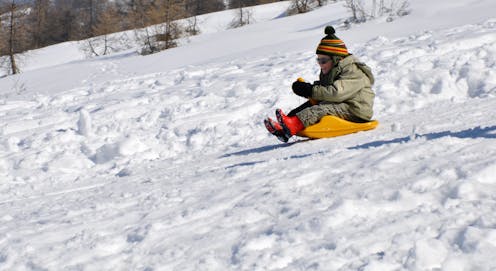How is snow made? An atmospheric scientist describes the journey of frozen ice crystals from clouds to the ground
- Written by Alexandria Johnson, Professor of Atmospheric and Planetary Sciences, Purdue University

Liquid water as glue
When snow falls from the sky, you don’t usually see individual ice crystals, but rather clumps of crystals stuck together[9]. One way ice crystals aggregate is through what’s called mechanical interlocking. When ice crystals bump into each other, crystals with intricate branches and arms intertwine and stick to others.
This mechanism is the main sticking process in cooler, drier conditions – what people call a “dry snow[10].” The result is a snow perfect for skiing, and easily picked up by the wind, but that won’t hold together when formed into a snowball.
The second way to stick ice crystals together is to warm them up a bit. When ice crystals fall through a region of cloud or atmosphere where the temperature is slightly above freezing, the edges of the crystals start to melt. Just a tiny bit of liquid water allows ice crystals that bump into each other to stick together very efficiently, almost like glue.
The result? Large clumps of ice crystals falling from the sky, what we call a “wet snow[11]” – less than ideal for hitting the slopes but perfect for building a snowman.
Snow formed in clouds typically reaches the ground only in winter. But almost all clouds, no matter the time of year or location, contain some ice[12]. This is true even for clouds in warm tropical regions, because the atmosphere above us is much colder and can reach temperatures below freezing even on the warmest of days. In fact, scientists who study weather discovered that clouds containing ice produce more rain than those that don’t contain any ice at all.
Hello, curious kids! Do you have a question you’d like an expert to answer? Ask an adult to send your question to CuriousKidsUS@theconversation.com[13]. Please tell us your name, age and the city where you live.
And since curiosity has no age limit – adults, let us know what you’re wondering, too. We won’t be able to answer every question, but we will do our best.
References
- ^ Curious Kids (theconversation.com)
- ^ curiouskidsus@theconversation.com (theconversation.com)
- ^ professor of atmospheric and planetary sciences (www.eaps.purdue.edu)
- ^ I’ve studied how ice crystals floating (scholar.google.com)
- ^ a cloud is born (climatekids.nasa.gov)
- ^ characteristic shapes of snowflakes (www.timeforkids.com)
- ^ No two snowflakes are exactly alike (www.willyswilderness.org)
- ^ LiLi/iStock via Getty Images Plus (www.gettyimages.com)
- ^ crystals stuck together (scied.ucar.edu)
- ^ dry snow (compuweather.com)
- ^ wet snow (www.acurite.com)
- ^ contain some ice (scijinks.gov)
- ^ CuriousKidsUS@theconversation.com (theconversation.com)
Authors: Alexandria Johnson, Professor of Atmospheric and Planetary Sciences, Purdue University

